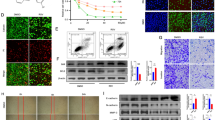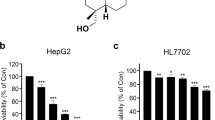Abstract
Background
The main therapies for cancer often results in many side effects and drug resistance. Gamma linolenic acid (GLA) is a kind of natural reagent with negligible cytotoxicity.
Objective
This work aims at detecting whether GLA possesses anti-cancer activity in NSCLC cells and elucidating the potential molecular mechanism.
Methods
Cytotoxicity of GLA was evaluated by MTT assay and soft agar colony formation method. Immunoblotting analysis examined the effect of GLA on protein expressions of cell proliferation markers (e.g., PCNA, Ki-67 and MCM2), pro-survival protein bcl-2, apoptosis-associated proteins (e.g., bax and cleaved caspase 3), HIF1α and VEGF. Wound healing assay and transwell invasion assay were performed to test the effect of GLA on hypoxia-induced cell migration and invasion. Cell transfection was used to overexpress HIF1α followed by the treatment of GLA to test the effect of HIF1α overexpression on the tumoricidal activity of GLA in NSCLC cell lines.
Results
MTT and soft agar colony formation tests showed that GLA dose-dependently suppressed cell proliferation in both Calu-1 and SK-MES-1 cell lines. Immunoblotting analysis demonstrated that GLA suppressed protein expressions of PCNA, Ki-67, MCM2 and bcl-2, while GLA induced bax and cleaved caspase 3 expressions. Wound healing assay and transwell invasion assay revealed that GLA was very effective on the inhibition of NSCLC cell migration and invasion. Immunoblotting analysis and cell transfection method indicated that GLA inhibited hypoxia-induced cell proliferation and invasion by suppressing HIF1α-VEGF pathway.
Conclusion
GLA suppresses hypoxia-induced proliferation and invasion of NSCLC cells by inhibition of HIF1α pathway in vitro.





Similar content being viewed by others
Data availability
All data generated or analyzed during this study are included in this published article.
References
Abbott SK, Else PL, Atkins TA, Hulbert AJ (2012) Fatty acid composition of membrane bilayers: importance of diet polyunsaturated fat balance. Biochim Biophys Acta 1818:1309–1317
Al Tameemi W, Dale TP, Al-Jumaily RMK, Forsyth NR (2019) Hypoxia-modified cancer cell metabolism. Front Cell Dev Biol 7:4
Colquhoun A (2002) Gamma-linolenic acid alters the composition of mitochondrial membrane subfractions, decreases outer mitochondrial membrane binding of hexokinase and alters carnitine palmitoyltransferase I properties in the Walker 256 rat tumour. Biochim Biophys Acta 1583:74–84
Das UN, Madhavi N (2011) Effect of polyunsaturated fatty acids on drug-sensitive and resistant tumor cells in vitro. Lipids Health Dis 10:159–159
Ge H, Kong X, Shi L, Hou L, Liu Z, Li P (2013) Gamma-linolenic acid induces apoptosis and lipid peroxidation in human chronic myelogenous leukemia K562 cells. Cell Biol Int 33:402–410
Giorgio V, Stockum SV, Antoniel M, Fabbro A, Fogolari F, Forte M, Glick GD, Petronilli V, Zoratti M, Szabó I et al (2013) Dimers of mitochondrial ATP synthase form the permeability transition pore. Proc Natl Acad Sci USA 110:5887–5892
Guo L, Carraro M, Sartori G, Minervini G, Eriksson O, Petronilli V, Bernardi P (2018) Arginine 107 of yeast ATP synthase subunit g mediates sensitivity of the mitochondrial permeability transition to phenylglyoxal. J Biol Chem 293:14632–14645
Guo L, Carraro M, Carrer A, Minervini G, Urbani A, Masgras I, Tosatto SC, Szabò I, Bernardi P, Lippe G (2019) Arg-8 of yeast subunit e contributes to the stability of F-ATP synthase dimersand to the generation of the full-conductance megachannel. J Biol Chem 294(28):10987–10997
Hockel M, Vaupel P (2001) Tumor hypoxia: definitions and current clinical, biologic, and molecular aspects. J Natl Cancer Inst 93:266–276
Kapoor R, Huang YS (2006) Gamma linolenic acid: an antiinflammatory omega-6 fatty acid. Curr Pharm Biotechnol 7(6):531–534
Li Y, Zhang D, Wang X, Yao X, Ye C, Zhang S, Wang H, Chang C, Xia H, Wang YC et al (2015) Hypoxia-inducible miR-182 enhances HIF1α signaling via targeting PHD2 and FIH1 in prostate cancer. Sci Rep 5:12495
Maxwell P, Pugh C, Ratcliffe PJ (2001) Activation of the HIF pathway in cancer. Curr Opin Genet Dev 11:293–299
Menéendez JA, Ropero S, Barbacid MDM, Montero S, Solanas M, Escrich E, Cortés-Funes H, Colomer R (2002) Synergistic interaction between vinorelbine and gamma-linolenic acid in breast cancer cells. Breast Cancer Res Treat 72:203–219
Minet E, Mottet D, Michel G, Roland I, Michiels C (1999) Hypoxia-induced activation of HIF-1: Role of HIF-1 alpha-Hsp90 interaction. FEBS Lett 460:251–256
Muz B, de la Puente P, Azab F, Azab AK (2015) The role of hypoxia in cancer progression, angiogenesis, metastasis, and resistance to therapy. Hypoxia 3:83–92
Papathanassiu AE, MacDonald NJ, Bencsura A, Vu HA (2006) F1F0-ATP synthase functions as a co-chaperone of Hsp90–substrate protein complexes. Biochem Biophys Res Commun 345:419–429
Petrova V, Annicchiarico-Petruzzelli M, Melino G, Amelio I (2018) The hypoxic tumour microenvironment. Oncogenesis 7:10
Sasaki T, Rodig SJ, Chirieac LR, Jänne PA (2010) The biology and treatment of EML4-ALK non-small cell lung cancer. Eur J Cancer 46:1773–1780
Shaikh SR, Edidin M (2006) Polyunsaturated fatty acids, membrane organization, T cells, and antigen presentation. Am J Clin Nutr 419:1277–1289
Thun MJ, DeLancey JO, Center MM, Jemal A, Ward EM (2009) The global burden of cancer: priorities for prevention. Carcinogenesis 31:100–110
Wang GL, Jiang B-H, Rue EA, Semenza GL (1995) Hypoxia-inducible factor 1 is a basic-helix-loop-helix-PAS heterodimer regulated by cellular O2 tension. Proc Natl Acad Sci USA 92:5510–5514
Yin Y, Sui C, Meng F, Ma P, Jiang Y (2017) The omega-3 polyunsaturated fatty acid docosahexaenoic acid inhibits proliferation and progression of non-small cell lung cancer cells through the reactive oxygen species-mediated inactivation of the PI3K /Akt pathway. Lipids Health Dis 16:87
Acknowledgements
Not applicable.
Funding
Not applicable.
Author information
Authors and Affiliations
Contributions
YW conceived and designed the experiments, JS analyzed and interpreted the results of the experiments, LYG performed the experiments.
Corresponding author
Ethics declarations
Conflict of interest
Yan Wang, Jian Shi and Liya Gong declare that they have no conflict of interest.
Ethical approval
The animal use protocol listed below has been reviewed and approved by the Animal Ethical and Welfare Committee.
Informed consent
Written informed consent was obtained from a legally authorized representative(s) for anonymized patient information to be published in this article.
Additional information
Publisher's Note
Springer Nature remains neutral with regard to jurisdictional claims in published maps and institutional affiliations.
Rights and permissions
About this article
Cite this article
Wang, Y., Shi, J. & Gong, L. Gamma linolenic acid suppresses hypoxia-induced proliferation and invasion of non-small cell lung cancer cells by inhibition of HIF1α. Genes Genom 42, 927–935 (2020). https://doi.org/10.1007/s13258-020-00961-5
Received:
Accepted:
Published:
Issue Date:
DOI: https://doi.org/10.1007/s13258-020-00961-5




